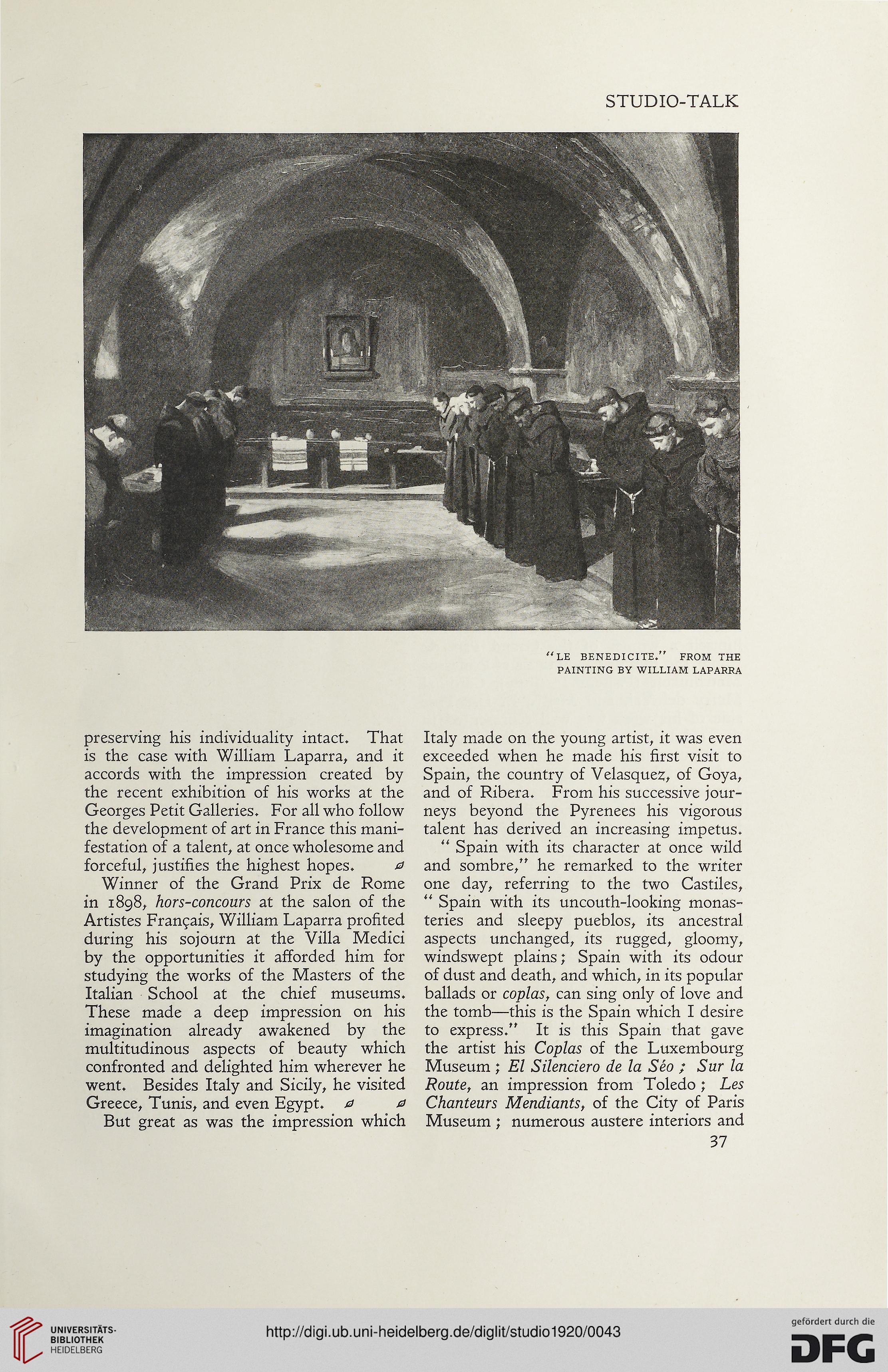STUDIO-TALK
“ LE BENEDICITE.” FROM THE
PAINTING BY WILLIAM LAPARRA
preserving his individuality intact. That
is the case with William Laparra, and it
accords with the impression created by
the recent exhibition of his works at the
Georges Petit Galleries. For all who follow
the development of art in France this mani-
festation of a talent, at once wholesome and
forceful, justifies the highest hopes. 0
Winner of the Grand Prix de Rome
in 1898, hors-concours at the salon of the
Artistes Frangais, William Laparra profited
during his sojourn at the Villa Medici
by the opportunities it afforded him for
studying the works of the Masters of the
Italian School at the chief museums.
These made a deep impression on his
imagination already awakened by the
multitudinous aspects of beauty which
confronted and delighted him wherever he
went. Besides Italy and Sicily, he visited
Greece, Tunis, and even Egypt. 0 0
But great as was the impression which
Italy made on the young artist, it was even
exceeded when he made his first visit to
Spain, the country of Velasquez, of Goya,
and of Ribera. From his successive jour-
neys beyond the Pyrenees his vigorous
talent has derived an increasing impetus.
“ Spain with its character at once wild
and sombre,” he remarked to the writer
one day, referring to the two Castiles,
** Spain with its uncouth-looking monas-
teries and sleepy pueblos, its ancestral
aspects unchanged, its rugged, gloomy,
windswept plains; Spain with its odour
of dust and death, and which, in its popular
ballads or coplas, can sing only of love and
the tomb—this is the Spain which I desire
to express.” It is this Spain that gave
the artist his Coplas of the Luxembourg
Museum ; El Silenciero de la Seo ; Sur la
Route, an impression from Toledo ; Les
Chanteurs Mendiants, of the City of Paris
Museum ; numerous austere interiors and
37
“ LE BENEDICITE.” FROM THE
PAINTING BY WILLIAM LAPARRA
preserving his individuality intact. That
is the case with William Laparra, and it
accords with the impression created by
the recent exhibition of his works at the
Georges Petit Galleries. For all who follow
the development of art in France this mani-
festation of a talent, at once wholesome and
forceful, justifies the highest hopes. 0
Winner of the Grand Prix de Rome
in 1898, hors-concours at the salon of the
Artistes Frangais, William Laparra profited
during his sojourn at the Villa Medici
by the opportunities it afforded him for
studying the works of the Masters of the
Italian School at the chief museums.
These made a deep impression on his
imagination already awakened by the
multitudinous aspects of beauty which
confronted and delighted him wherever he
went. Besides Italy and Sicily, he visited
Greece, Tunis, and even Egypt. 0 0
But great as was the impression which
Italy made on the young artist, it was even
exceeded when he made his first visit to
Spain, the country of Velasquez, of Goya,
and of Ribera. From his successive jour-
neys beyond the Pyrenees his vigorous
talent has derived an increasing impetus.
“ Spain with its character at once wild
and sombre,” he remarked to the writer
one day, referring to the two Castiles,
** Spain with its uncouth-looking monas-
teries and sleepy pueblos, its ancestral
aspects unchanged, its rugged, gloomy,
windswept plains; Spain with its odour
of dust and death, and which, in its popular
ballads or coplas, can sing only of love and
the tomb—this is the Spain which I desire
to express.” It is this Spain that gave
the artist his Coplas of the Luxembourg
Museum ; El Silenciero de la Seo ; Sur la
Route, an impression from Toledo ; Les
Chanteurs Mendiants, of the City of Paris
Museum ; numerous austere interiors and
37




